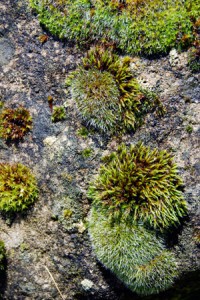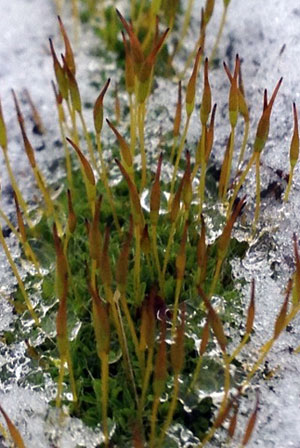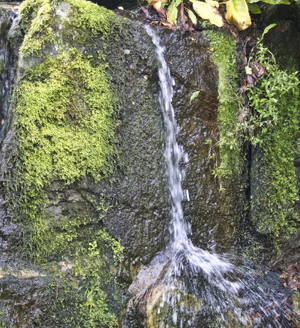Invasion of the land : mosses, bryophytes and climate change.

Throughout the twentieth century, stations like that at Manua Loa have monitored the level of carbon dioxide in the air. It is clear that atmospheric concentrations of carbon dioxide have risen from about from about 300 ppm in the 1960’s to nearly 400 ppm by 2010.
However, if we look back some 480 million years (to the Ordivician Period) the level of carbon dioxide was some sixteen times higher than the present level and the average global temperature was about 25 oC, that is, about 10 oC higher than today’s average. So how and why has global temperature fallen ?
The ‘usual’ explanation is that the global temperature began to fall when land plants in the form of vascular plants (ferns, tree ferns and similar) began to take in vast quantities of carbon dioxide for photosynthesis – ‘locking’ it up in the form of carbon compounds (sugars, cellulose, lignin – some of which later became coal). As the carbon dioxide level fell so polar ice caps began to form.
However, Professors Lenton (Exeter University) and Dolan (Oxford) have proposed a slightly different formulation of this model. Their research team used the moss, Physcomitrella patens , in their study. Using incubators as environmental chambers, they placed rocks with and without moss into the incubators for some months and monitored the effects of the mosses on the rocks.
They have suggested that a critical event leading to the reduction of carbon dioxide levels was the invasion of the land by the first ‘simple’ land plants. These would have provided a ‘carpet’ of greenery of plants , not dis-similar to our present day mosses and liverworts (Bryophytes).
 The invasion of the land and rocks by these simple moss-like plants had a number of consequences
The invasion of the land and rocks by these simple moss-like plants had a number of consequences
(1). The first land plants interacted with the rocks – inducing a form of chemical weathering. This leads to the release of elements like Calcium and Magnesium from the rocks, which in turn interact with carbon dioxide in the atmosphere.
(2). The plants also released phosphates and iron, which would have washed down into the seas and oceans, where they would have ‘fuelled’ the process of photosynthesis in the algae of the surface layers.
(3). The e
arly land plants would also have an appetite for carbon dioxide, absorbing it from the atmosphere, again for photosynthesis.
These various processes would contribute to a significant fall in the level of carbon dioxide in the atmosphere, and the consequent change in climate. So the early simple land plants, such as mosses and liverworts etc were important players in the geochemical cycles of these eperiods in the earth's history – affecting significant climate change. Just as the woods, forests and algae of the oceans are major players in the uptake and circulation of carbon dioxide today- so many millions of years ago, simple plants like the mosses and bryophytes had a central role in the ‘adjustment / control’ of climate.
Mosses and liverworts may not be a dominant life form nowadays but they are still to be found in our hedgerows and woodlands, contributing to the diversity of life and offering micro-habitats for various insects and other invertebrates.
The Field Studies Council offers a number of courses on mosses and bryophytes ……
http://www.field-studies-council.org/individuals-and-families/courses/2012/or/mosses-and-liverworts-as-indicators-of-climate-change-
and more at http://www.field-studies-council.org/index.aspx
Comments are closed for this post.
Discussion
[…] may not be a dominant life form nowadays but they are still to be found in our hedgerows and woodlands, contributing to the diversity of […]
a fine write up, Bryophytes are a fascinating plant range with very little in the way of coverage, especially within the gardening circles.


see also the Oxford Science blog
http://www.ox.ac.uk/media/science_blog/120201.html
Chris
7 February, 2013